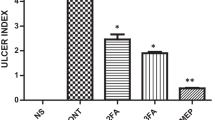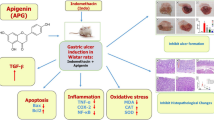Abstract
Background
A recent study reported that in addition to their inhibitory effect on gastric acid secretion, some proton pump inhibitors also exert a cytoprotective effect on the gastric mucosa. We investigated the effects of lansoprazole (LPZ) on the epithelial cell cycle, and on the expressions of vascular endothelial growth factor (VEGF) and matrix metalloproteinase-2 (MMP-2).
Methods
We examined the effects of 25 and 5 mg/kg LPZ on ulcer healing in an acetic acid-induced ulcer model in rats with and without indomethacin (IND) treatment. On days 14 and 28 after ulcer formation, we compared the ulcer diameter, bromodeoxyuridine (BrdU) uptake, apoptosis, vascular density, and the expressions of VEGF and MMP-2 in the different groups.
Results
LPZ administration increased the BrdU uptake that was reduced by IND administration. LPZ administration also increased VEGF expression at the ulcer margin in a dose-dependent manner. However, LPZ administration did not increase VEGF expression following IND pretreatment. Administration of IND alone significantly decreased MMP-2 expression at the ulcer margin; on the other hand, subsequent administration of LPZ increased the MMP-2 expression.
Conclusion
One of the mechanisms of ulcer healing brought about by LPZ may be the involvement of endogenous prostaglandin (PG) secretion. The effect of endogenous PG secretion may be related to the induction of VEGF expression. On the other hand, LPZ administration increased MMP-2 expression, and this effect was not influenced by the inhibition of PG synthesis. The mechanisms of LPZ on ulcer healing may be involved by VEGF expression through endogenous PGs secretion. Additionally, the stimulated expression of MMP-2, which is not secreted by endogenous PGs, is another important factor for ulcer healing by LPZ.








Similar content being viewed by others
Abbreviations
- PPI:
-
Proton pump inhibitor
- LPZ:
-
Lansoprazole
- VEGF:
-
Vascular endothelial growth factor
- MMP:
-
Matrix metalloproteinase
- PG:
-
Prostaglandin
- IND:
-
Indomethacin
- BrdU:
-
Bromodeoxyuridine
- TUNEL:
-
Terminal uridine deoxynucleotide nick end-labeling
References
Satoh H, Inatomi N, Nagaya H, Inada I, Nohara A, Nakamura N, et al. Antisecretory and antiulcer activities of a novel proton pump inhibitor AG-1749 in dogs and rats. J Pharmacol Exp Ther. 1989;248:806–15.
Nagaya H, Satoh H, Maki Y. Possible mechanism for the inhibition of acid formation by the proton pump inhibitor AG-1749 in isolated canine parietal cells. J Pharmacol Exp Ther. 1990;252:1289–95.
Capodicasa E, De Bellis F, Pelli MA. Effect of lansoprazole on human leukocyte function. Immunopharmacol Immunotoxicol. 1999;21:357–77.
Inada I, Satoh H. Capsaicin-sensitive sensory neurons are involved in bicarbonate secretion induced by lansoprazole, a proton pump inhibitor, in rats. Dig Dis Sci. 1996;41:785–90.
Asaki S, Sato A, Sakurada H, Takeda T, Hongo M, Toyota T. Clinical evaluation of lansoprazole in the treatment of peptic ulcers: initial healing and prevention of relapse. Tohoku Peptic Ulcer Study Group. J Clin Gastroenterol. 1995;20(Suppl 2):S56–8.
Tsuji S, Sun WH, Tsujii M, Kawai N, Kimura A, Kakiuchi Y, et al. Lansoprazole induces mucosal protection through gastrin receptor-dependent up-regulation of cyclooxygenase-2 in rats. J Pharmacol Exp Ther. 2002;303:1301–8.
Konturek SJ, Brzozowski T, Radecki T. Protective action of omeprazole, a benzimidazole derivative, on gastric mucosal damage by aspirin and ethanol in rats. Digestion. 1983;27:159–64.
Ferrara N, Davis-Smyth T. The biology of vascular endothelial growth factor. Endocr Rev. 1997;18:4–25.
Jones MK, Kawanaka H, Baatar D, Szabo IL, Tsugawa K, Pai R, et al. Gene therapy for gastric ulcers with single local injection of naked DNA encoding VEGF and angiopoietin-1. Gastroenterology. 2001;121:1040–7.
Shahin M, Konturek JW, Pohle T, Schuppan D, Herbst H, Domschke W. Remodeling of extracellular matrix in gastric ulceration. Microsc Res Tech. 2001;53:396–408.
Swarnakar S, Ganguly K, Kundu P, Banerjee A, Maity P, Sharma AV. Curcumin regulates expression and activity of matrix metalloproteinases 9 and 2 during prevention and healing of indomethacin-induced gastric ulcer. J Biol Chem. 2005;280:9409–15.
Ito A, Nagase H, Mori Y. Characterization of metalloproteinases in rat gastric tissues with acetic acid-induced ulcers. Scand J Gastroenterol Suppl. 1989;162:146–9.
Okabe S, Amagase K. An overview of acetic acid ulcer models—the history and state of the art of peptic ulcer research. Biol Pharm Bull. 2005;28:1321–41.
Blandizzi C, Fornai M, Colucci R, Natale G, Lubrano V, Vassalle C, et al. Lansoprazole prevents experimental gastric injury induced by non-steroidal anti-inflammatory drugs through a reduction of mucosal oxidative damage. World J Gastroenterol. 2005;11:4052–60.
Konturek SJ, Konturek PC, Brzozowski T. Prostaglandins and ulcer healing. J Physiol Pharmacol. 2005;56(Suppl 5):5–31.
Levi S, Goodlad RA, Lee CY, Stamp G, Walport MJ, Wright NA, et al. Inhibitory effect of non-steroidal anti-inflammatory drugs on mucosal cell proliferation associated with gastric ulcer healing. Lancet. 1990;336:840–3.
Li X, Traganos F, Melamed MR, Darzynkiewicz Z. Single-step procedure for labeling DNA strand breaks with fluorescein- or BODIPY-conjugated deoxynucleotides: detection of apoptosis and bromodeoxyuridine incorporation. Cytometry. 1995;20:172–80.
Yokoyama K, Nakajima N, Ito Y, Iwasaki A, Arakawa Y. Histoimmunological evaluation for the efficacy of entero nutrient containing n-3 fatty acid in TNBS rat colitis model. J Clin Biochem Nutr. 2006;9:88–97.
Tanigawa T, Watanabe T, Higuchi K, Machida H, Okazaki H, Yamagami H, et al. Lansoprazole, a proton pump inhibitor, suppresses production of tumor necrosis factor-alpha and interleukin-1 beta induced by lipopolysaccharide and Helicobacter pylori bacterial components in human monocytic cells via inhibition of activation of nuclear factor-kappaB and extracellular signal-regulated kinase. J Clin Biochem Nutr. 2009;45:86–92.
Takagi T, Naito Y, Okada H, Ishii T, Mizushima K, Akagiri S, et al. Lansoprazole, a proton pump inhibitor, mediates anti-inflammatory effect in gastric mucosal cells through the induction of heme oxygenase-1 via activation of NF-E2-related factor 2 and oxidation of kelch-like ECH-associating protein 1. J Pharmacol Exp Ther. 2009;331:255–64.
Laine L, Takeuchi K, Tarnawski A. Gastric mucosal defense and cytoprotection: bench to bedside. Gastroenterology. 2008;135:41–60.
Shweiki D, Itin A, Neufeld G, Gitay-Goren H, Keshet E. Patterns of expression of vascular endothelial growth factor (VEGF) and VEGF receptors in mice suggest a role in hormonally regulated angiogenesis. J Clin Invest. 1993;91:2235–43.
Hatazawa R, Tanaka A, Tanigami M, Amagase K, Kato S, Ashida Y, et al. Cyclooxygenase-2/prostaglandin E2 accelerates the healing of gastric ulcers via EP4 receptors. Am J Physiol Gastrointest Liver Physiol. 2007;293:G788–97.
Wallace JL, Dicay M, McKnight W, Dudar GK. Platelets accelerate gastric ulcer healing through presentation of vascular endothelial growth factor. Br J Pharmacol. 2006;148:274–8.
Majima M, Hayashi I, Muramatsu M, Katada J, Yamashina S, Katori M. Cyclo-oxygenase-2 enhances basic fibroblast growth factor-induced angiogenesis through induction of vascular endothelial growth factor in rat sponge implants. Br J Pharmacol. 2000;130:641–9.
Fu S, Ramanujam KS, Wong A, Fantry GT, Drachenberg CB, James SP, et al. Increased expression and cellular localization of inducible nitric oxide syntheses and cyclooxygenase 2 in Helicobacter pylori gastritis. Gastroenterology. 1999;116:1319–29.
Tanaka A, Hase S, Miyazawa T, Takeuchi K. Up-regulation of cyclooxygenase-2 by inhibition of cyclooxygenase-1: a key to nonsteroidal anti-inflammatory drug-induced intestinal damage. J Pharmacol Exp Ther. 2001;300:754–60.
Takeuchi K, Tanaka A, Hayashi Y, Kubo Y. Functional mechanism underlying COX-2 expression following administration of indomethacin in rat stomachs: importance of gastric hypermotility. Dig Dis Sci. 2004;49:180–7.
Miura S, Tatsuguchi A, Wada K, Takeyama H, Shinji Y, Hiratsuka T, et al. Cyclooxygenase-2-regulated vascular endothelial growth factor release in gastric fibroblasts. Am J Physiol Gastrointest Liver Physiol. 2004;287:G444–51.
Holzer P. Neural emergency system in the stomach. Gastroenterology. 1998;114:823–39.
Takeuchi K, Matsuumoto J, Ueshima K, Okabe S. Role of capsaicin-sensitive afferent neurons in alkaline secretory response to luminal acid in the rat duodenum. Gastroenterology. 1991;101:954–61.
Ohno T, Hattori Y, Komine R, Mizuguchi S, Arai K, Saeki T, et al. Roles of calcitonin gene-related peptide in maintenance of gastric mucosal integrity and in enhancement of ulcer healing and angiogenesis. Gastroenterology. 2008;134:215–25.
Lempinen M, Inkinen K, Wolff H, Ahonen J. Matrix metalloproteinases 2 and 9 in indomethacin-induced rat gastric ulcer. Eur Surg Res. 2000;32:169–76.
Koolwijk P, van Erck MG, de Vree WJ, Vermeer MA, Weich HA, Hanemaaijer R, et al. Cooperative effect of TNFalpha, bFGF, and VEGF on the formation of tubular structures of human microvascular endothelial cells in a fibrin matrix. Role of urokinase activity. J Cell Biol. 1996;132:1177–88.
Zahner G, Harendza S, Müller E, Wolf G, Thaiss F, Stahl RA. Prostaglandin E2 stimulates expression of matrix metalloproteinase 2 in cultured rat mesangial cells. Kidney Int. 1997;51:1116–23.
Calabro A, Grappone C, Pellegrini G, Evangelista S, Tramontana M, Schuppan D, et al. Spatial and temporal pattern of expression of interstitial collagenase, stromelysin/transin, gelatinase A and TIMP-1 during experimental gastric ulcer healing. Digestion. 2004;70:127–38.
Tatsuguchi A, Fukuda Y, Ishizaki M, Yamanaka N. Localization of matrix metalloproteinases and tissue inhibitor of metalloproteinases-2 in normal human and rabbit stomachs. Digestion. 1999;60:246–54.
Author information
Authors and Affiliations
Corresponding author
Rights and permissions
About this article
Cite this article
Kobayashi, S., Nakajima, N., Ito, Y. et al. Effects of lansoprazole on the expression of VEGF and cellular proliferation in a rat model of acetic acid-induced gastric ulcer. J Gastroenterol 45, 846–858 (2010). https://doi.org/10.1007/s00535-010-0224-6
Received:
Accepted:
Published:
Issue Date:
DOI: https://doi.org/10.1007/s00535-010-0224-6




